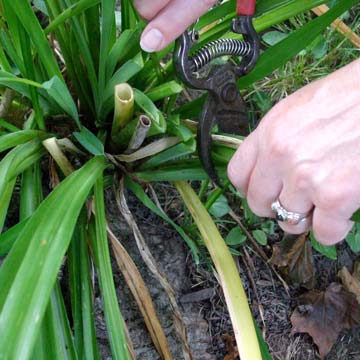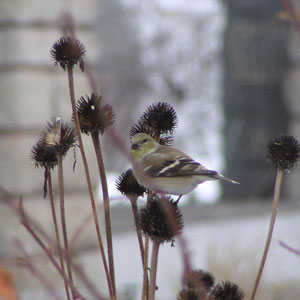Today’s gardeners wrestle with whether to cut back perennials in fall or leave them upright until spring.
It used to be common practice to cut perennials back in fall to reduce the chance that insects or diseases would winter over on the plants or in fallen debris. Removing the seed heads of plants reduces self-sowing, too. In more recent years, a dilemma has risen as gardeners have learned that leaving plants upright is beneficial to pollinators and other beneficial insects. And sometimes, the plants look good in the winter landscape.
 Cut back daylilies to the ground in late fall to keep the garden tidy.
Cut back daylilies to the ground in late fall to keep the garden tidy.
© Jo Ellen Meyers Sharp
 Goldfinches feed on the seeds of coneflowers and black-eyed Susan in winter.
Goldfinches feed on the seeds of coneflowers and black-eyed Susan in winter.
© Photo courtesy University of Nebraska-Extension
 The tall sedum stands upright in winter, capturing caps of snow.
The tall sedum stands upright in winter, capturing caps of snow.
© Marty Patch/iStockphoto.com
Whether you leave some plants up or cut them back is up to you. However, there are some that are best cut back, such as any plants that have been infested with insects or disease. And sometimes, because they simply look untidy.
Perennials to cut back
Hosta. Cut back to base of plant, preferable before a hard freeze, which turns the leaves into mush, making them harder to remove. Ugly.
Garden phlox. Cut to the ground when it stops blooming. Usually the leaves turn brown, making the plant unattractive.
Daylilies. Some are semi-evergreen, but cutting daylilies back to the ground in late fall or early winter keep the bed tidy looking.
Iris. The theory of cutting back perennials to reduce insect infestation holds true for irises, especially the German iris. Iris borers emerge in late summer and lay their eggs on the dried leaves. The eggs hatch in spring and burrow into the new leaf growth. The larva eventually work their way to the rhizomes, causing them to rot.
Peony. Cutting back peony and removing fallen leaves in fall reduces the chance fungus and other disease will contaminate new growth next spring.
Perennials to cut back or leave up
Coneflowers. These will self sow, but the birds, especially goldfinches, dine on the seed heads all winter.
Black-eyed Susan. These, too, self sow, but the birds like the seeds.
Astilbe. The leaves will disappear, but the seed heads stay upright, adding a bit of interest to the winter landscape.
Japanese anemone. The seed heads look like cotton balls atop sturdy stems that look nice in the winter landscape.
Sedum. Many of the short, ground-cover types are evergreen. The tall ones usually stay upright and look good in the winter landscape. Birds nibble the seeds, too.
by Jo Ellen Meyers Sharp